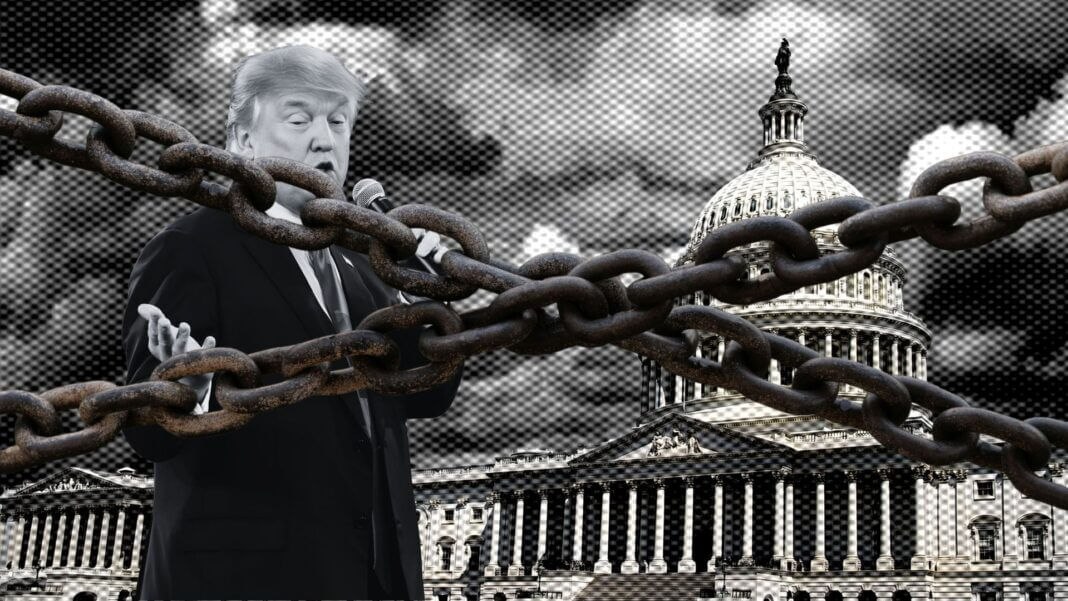Six months into Donald Trump’s second term, the scoreboard tells a familiar story. The man who promised to “drain the swamp” finds himself drowning in it instead. Despite controlling both houses of Congress and wielding executive power, Trump has failed to deliver on his most fundamental campaign promises—and the reasons why should concern every Texan who still believes the Federal system can be fixed.
From auditing Fort Knox to eliminating the income tax, from releasing the Epstein files to ending the Ukraine war, Trump’s unfulfilled pledges aren’t just political disappointments. They’re proof that the Federal bureaucracy has become so entrenched, so resistant to change, that even the most determined outsider cannot bend it to the will of the people.
For Texans, this reality should serve as the final wake-up call. If Trump can’t reform Washington, no one can.
The Gold That Isn’t There. Or Is It?
Trump’s promise to audit Fort Knox seemed simple enough. “We do want to know” if the gold is still there, he declared from Air Force One in February, echoing concerns raised by Elon Musk and Senator Rand Paul. The last comprehensive audit of America’s gold reserves happened in the 1950s, leaving decades of questions unanswered.
Yet six months later, no audit has materialized. Initial plans announced in February evaporated by May. Treasury Secretary Scott Bessent dismissed the effort, insisting that “routine audits suffice” and claiming there’s “no evidence that any gold is missing.” Senator Paul’s formal request went unanswered. A bipartisan bill for a full audit remains buried in congressional committees.
If the Federal Government can’t manage a simple audit of its own assets, how can we trust it with anything more complex? The bureaucracy’s resistance to this basic accountability measure reveals an institution that operates in darkness by design.
The Tax Promise That Couldn’t Escape the Swamp
Perhaps no promise was more ambitious than Trump’s pledge to eliminate the Federal income tax entirely, replacing it with tariffs. “We can get rid of the income tax and replace it with tariffs,” he declared in October 2024, promising to “abolish the IRS” and fund government through import duties alone.
The reality fell far short. The “One Big Beautiful Bill” signed on July 4th made permanent some tax cuts and added exemptions for tips and overtime, but the income tax structure remains intact. Instead of the elimination Trump promised, Americans got modest reductions—still paying into a system that extracts $2.4 trillion annually from their paychecks.
The Congressional Budget Office projects Trump’s actual tax changes will add $4.5 trillion to the national debt over ten years. Rather than eliminating the burden, Washington simply shifted it to future generations while maintaining its revenue streams.
Secrets the Swamp Won’t Release And the Base Revolt
Trump’s vow to release all Jeffrey Epstein-related files seemed like a test of whether transparency could pierce the Federal establishment’s veil of secrecy. “I will release the Epstein files,” he promised, calling for full disclosure of any client lists or related documents.
The Department of Justice’s response was predictably bureaucratic. A July 6th memo concluded there’s “no client list” and no further documents warrant release. Attorney General Pam Bondi filed a request for grand jury transcripts, but as of late July, only limited, heavily redacted records have seen daylight.
What makes this failure particularly damaging is how it has turned Trump’s own supporters against him. Reports emerged on July 17th of Trump supporters burning MAGA hats in protest after the president dismissed further Epstein file releases as unnecessary. When Trump urged the public to “move on” from the issue, the backlash was swift and brutal.
A Reuters/Ipsos poll found 69% of Americans, including a significant portion of Republicans, believe the administration is concealing Epstein details. On social media, longtime Trump supporters accused him of a cover-up. “If the Epstein files were ‘made up,’ why did Pam Bondi say they were on her desk?” demanded one frustrated supporter. “The cover-up is the confession.”
When a president loses his own base over a transparency issue, it demonstrates that the Federal establishment’s power to protect its secrets transcends political loyalty.
The 24-Hour War That’s Still Raging
One of Trump’s most specific campaign promises was ending the Russia-Ukraine war “in 24 hours” upon taking office. He repeatedly claimed he could broker peace “before I even become president,” vowing to halt U.S. military aid to force both sides to negotiate.
Six months later, the war rages on with no ceasefire in sight. Trump has quietly backed away from his timeline, telling reporters in July that he was “unsure” if he could end the fighting—a stark shift from campaign rhetoric. In April, he called the 24-hour claim an “exaggeration” or “joke,” admitting the process has been “more difficult” than expected.
More troubling for his supporters, Trump has completely reversed course on military aid. On July 14th, he announced a plan to funnel more U.S.-made weapons to Ukraine via European allies, including Patriot missiles and potentially long-range Tomahawks worth “billions of dollars.” NATO countries would purchase American arms and transfer them to Ukraine—a shell game that increases weapons flow while technically keeping Trump’s hands clean.
The reversal sparked what the BBC called “MAGA anger” for contradicting his anti-aid promises. Russia responded by calling it a signal for Ukraine to “abandon peace efforts.” Once again, the Federal foreign policy establishment had successfully co-opted a president who campaigned against their agenda.
The Deportation Reality Check
Mass deportations represented Trump’s signature domestic policy promise. He pledged the “largest deportation operation in American history,” targeting millions of undocumented immigrants using military resources and emergency declarations.
The numbers tell a different story. From January through May, ICE deported approximately 157,769 individuals—an increase from Biden-era levels but nowhere near the millions promised. Daily averages in early February actually ran 6.5% below Biden’s rates. By June, a CNN poll showed 55% of Americans viewed the deportation efforts as going “too far.”
Logistical constraints, court challenges, and economic disruption from labor shortages have slowed progress to a crawl. Even with executive authority and congressional support, the Federal system proved incapable of executing its own border security policies effectively.
The Untouchable Bureaucracy
Trump promised to prosecute Federal officials who “weaponized” government agencies against American citizens. He threatened to “investigate, prosecute, jail or otherwise punish” those responsible for what he called the politicization of law enforcement.
No major arrests of Federal officials have occurred. The administration has pursued some firings and investigations, but prosecutions remain limited to lower-level cases unrelated to the core promise. As of June, only five Democratic officials faced immigration-related arrests—hardly the systematic accountability Trump voters expected.
The bureaucracy’s ability to protect its own reveals an institution that operates above the law, immune to electoral consequences and resistant to outside oversight.
The Debt That Keeps Growing
Trump vowed to address the “unsustainable” debt path, promising cuts of “hundreds of billions” in Federal spending during 2025. Instead, the federal debt has climbed from $34.6 trillion at inauguration to $36 trillion by July, adding $1.4 trillion in just six months.
The Congressional Budget Office projects Trump’s policies will add $5.8 trillion to the debt over ten years. His first 100 days saw $200 billion more in spending than the promised cuts. The Federal Government’s addiction to deficit spending has proven stronger than any president’s reform agenda.
The Government That Won’t Shrink
Through the Department of Government Efficiency (DOGE), Trump pledged massive cuts to Federal employment, including 75% workforce reductions in some agencies. The goal was a “massive overhaul” to slash spending and eliminate redundancy.
By March, the Federal workforce had dropped by approximately 23,700 employees to 2.29 million—a reduction of just 1%. Over 275,000 layoffs were announced by June, but many were reversed due to lawsuits. Only about 75,000 employees took deferred resignations when offered.
DOGE has failed to meet its $2 trillion savings goal, with 100-day reviews showing limited efficiency gains. The bureaucracy’s resistance to downsizing has proven more powerful than executive directives.
The Base That’s Walking Away
Perhaps most telling is how Trump’s broken promises are fracturing his own coalition. The Epstein files debacle saw longtime supporters burning MAGA hats. The Ukraine aid reversal has been called a betrayal by anti-war conservatives. The failure to eliminate the income tax has left fiscal conservatives questioning his commitment to limited government.
When a president starts losing his own base over broken promises, it signals something deeper than political disappointment. It reveals a system so entrenched that even its supposed opponents become complicit in perpetuating it.
The Lesson for Texas
These failures aren’t accidents. They’re features of a system designed to resist change, protect entrenched interests, and maintain the status quo regardless of electoral outcomes. The Federal bureaucracy has become a fourth branch of government—unelected, unaccountable, and unchangeable.
For Texans, the implications are clear. If a president with Trump’s determination and resources cannot reform Washington, then reform is impossible. The Federal system has evolved beyond the reach of democratic accountability.
Every day Texas remains in this union, we surrender more of our sovereignty to this unresponsive machine. Every tax dollar we send to Washington feeds a bureaucracy that serves its own interests rather than ours. Every Federal regulation imposed on Texas comes from agencies that have proven immune to presidential control.
The choice facing Texas is no longer between reform and independence. Trump’s broken promises have eliminated reform as an option. The choice is between continued subjugation to an unreformable system or the restoration of self-government through independence.
When even Trump’s most loyal supporters are burning their MAGA hats in frustration, when campaign promises evaporate in the face of bureaucratic resistance, when foreign wars continue despite explicit commitments to end them, the message is unmistakable.
Washington has shown us who it really serves. Now Texas must decide who we’re going to serve—the entrenched bureaucracy that can’t be changed, or the people of Texas who deserve better.
The Federal system isn’t broken. It’s working exactly as designed—to perpetuate itself at our expense. That’s why it can’t be fixed, and that’s why Texas must leave.


